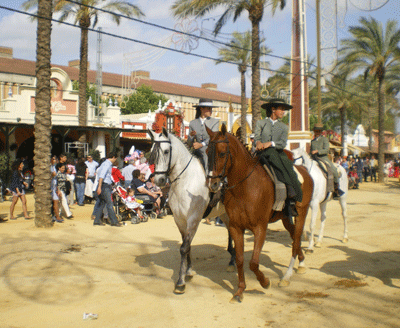An inspirational trip to Jerez
Octavia travels to Jerez to brush up on her dressage skills and see some wonderful displays of horsemanship

I have a new ambition in life: to ride in the Feria dos Caballos in Jerez, Spain - the Festival of the Horse, a chance to celebrate the horse and its place at the centre of Spanish life. Either arrayed in a red flamenco dress behind my dashing paramour on his grey Andalusian stallion, ruffles spilling over the horse's tail, or elegantly side-saddle in a wide-brimmed hat and a fitted bolero jacket. Or perhaps driving a dark-green carriage pulled by five horses unicorn-style, high-stepping through the crowds with harness bells jingling and pom-poms bouncing.
It is an ambition shared by every member of the Riding Club London with whom I travelled last week for a weekend of horsemanship and sherry in south-west Spain. Arriving at the Hacienda Buena Suerta (00 34 956 231 286; www.dysli-riding-vacations.com) amid rolling hills and dusty tracks, a magnificent seafood paella set the mood for a weekend in which we feasted on countless Spanish dishes and rich, local Serrano ham. We certainly worked hard on the horses, but I'm not at all sure that it was hard enough to stave off the effects of cheese drizzled in olive oil and exquisite post-lunch chocolates.

Comfortable rooms with smooth stone floors and soft rugs ensured we were well rested to take on the Feria in the morning-our leader Ashley Parasram assured our somewhat doubting faces that 12 hours in the hot sun and crowds would whiz by, and so it proved. Held in a park of beaten-earth and brick tracks, with a long main boulevard, wide streets leading off it, all of Spanish society-grandparents, courting couples and tiny children, more often than not on their own imposing steeds-gather to admire and be admired. I even saw a proud father with his wife behind him and a tiny baby in his arms, his bay stallion looking as proud as he. Horses are an integral part of life here, and I wondered what British health-and-safety officials would think of children running hither and thither between the parading horses and carriages. There are no barriers or safety rails, and the only rule for participating is that riders should be attired in traditional dress.

We began, naturally, in one of the dozens of sherry bars that line the street, then progressed on to another, and another, and a few more, interspersed with a ride on a bright yellow carriage, a shopping trip for gorgeous leather bags and boots, and displays of horsemanship. Admiration for the stallions performing piaffe (trotting on the spot) and extravagant half-passes (trotting and cantering sideways) gave way to amusement at the final act, in which a somewhat substantial gentleman on a dapple-grey horse wooed his lady love through the release of a rather dazed looking white dove and some horseback paso doble. The highlight, however, was Kenzie Dysli, daughter of Magda, the owner of our hacienda. She performed a flowing display of Spanish dressage, pirouettes, sliding stops from full gallop and hind-leg antics, all without either a saddle or bridle. The sight of that slight figure controlling her handsome, dark-bay horse with only a thin rope around his neck was quite magical.

At the end of the evening, still buzzing, we walked to the main Spanish Riding School for a magnificent display of tightly controlled dressage movements, with a score of riders criss-crossing the arena, and airs above the ground, including the breathtaking capriole, when the horse leaps into the air and kicks out its hind feet in a movement originally intended to strike down the enemy in battle.

The following morning was devoted to natural horsemanship, breaking a horse to harness by speaking its own language. It sounds ridiculous, but, by mirroring a horse's body language and taking on the role of the leader of the herd, it is possible to have a horse following you around, willing to do anything you ask, in hours. Nathan, a genuine cowboy from Tucson, Arizona, worked his magic on a cheeky two-year-old buckskin colt, who moved beautifully, when he wasn't thinking about eating the Western saddle in the middle of the ring. Magda's former husband, Jean-Claude Dysli, with whom she bought the hacienda, was the first to bring quarter-horses to Europe, and the stables are still known more for their Western riding than Spanish. We finished the weekend with a relaxed Western-style hack in the hills, strewn with wildflowers and herds of horses.
The rest of the time was spent trying to emulate the riders we had seen and, in my case, failing! It may look as if dressage riders aren't doing much, but it is tremendously sensitive and hard work, in which the slightest movement of your hips and seat can make all the difference. Having grown up hunting and careering round the countryside on a Welsh cob who, if you took her into an arena with no jumps set up, would go to sleep, and latterly spending my mornings hanging onto the iron-mouthed cavalry blacks, I felt singularly unprepared. But I learnt more than I have done in years, and I am now desperate for proper lessons so that when I return I may reach at least the bottom of the slope that leads to the explosive beauty of high Spanish dressage.
Exquisite houses, the beauty of Nature, and how to get the most from your life, straight to your inbox.
Country Life is unlike any other magazine: the only glossy weekly on the newsstand and the only magazine that has been guest-edited by His Majesty The King not once, but twice. It is a celebration of modern rural life and all its diverse joys and pleasures — that was first published in Queen Victoria's Diamond Jubilee year. Our eclectic mixture of witty and informative content — from the most up-to-date property news and commentary and a coveted glimpse inside some of the UK's best houses and gardens, to gardening, the arts and interior design, written by experts in their field — still cannot be found in print or online, anywhere else.
-
 Child stars, Prince and nursery rhymes: It's the Country Life Quiz of the Day, December 5, 2025
Child stars, Prince and nursery rhymes: It's the Country Life Quiz of the Day, December 5, 2025It's all in today's quiz.
-
 ‘Calf’s brains have a bland, gentle richness that soothes and cossets': Tom Parker Bowles on the joys of eating offal
‘Calf’s brains have a bland, gentle richness that soothes and cossets': Tom Parker Bowles on the joys of eating offalEating offal it is more sinned against than sinning, but it offers the ultimate in magnificent, fully immersive eating.
